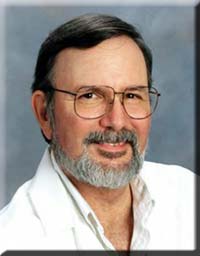
|
Dr. J. WILLIAM LOUDA
(Updated: November 10, 2004)
Department of Chemistry and Biochemistry
and
The Environmental Sciences Program
OFFICE: 121 Science and Engineering
OFFICE HOURS: 11:00AM-12:30PM M-F
(561) 297-3309 - Office phone
(561) 297-3998 - Laboratory phone
(561) 297-2759 - FAX
blouda@fau.edu |
Research Interests
Lab Tour Vita/Publications Florida Oceans Day
I am an Associate Scientist (Faculty Member) in the Department of Chemistry and Biochemistry at Florida Atlantic University on its main campus in Boca Raton, Florida. As an environmental biogeochemist, I am able to offer students graduate research towards the M.S., M.S.T. or Ph.D. in Chemistry and Biochemistry and, as a member of the Environmental Sciences program teaching one of its core courses, I also accept students towards the M.S. in Environmental Sciences. Additionally, I will accept “DIS” (= Directed Independent Study) students in Chemistry and other disciplines upon request. Research topics can cover quite a wide variety of interests, anything from the environment to in vitro chemistry (mixing stuff in test tubes).
Teaching Assistantships (TA) are usually available and are accompanied by significant tuition support. Periodically, research assistantships (RA) are also available (inquire).
Currently, my main research support, interest and activity is involved with microalgal community dynamics in the overall Everglades system. Namely, I have projects in Lake Okeechobee, the Everglades proper (periphyton see http://www.sfwmd.gov), and Florida Bay (http://www.aoml.noaa.gov/ocd/sferpm/louda/louda_algal_blooms.html). These projects are all entwined into the Comprehensive Everglades Restoration Plan (CERP http://www.evergladesplan.org).
My philosophy with graduate students is to have them perform a wide variety of tasks related to their research and an overall research experience. That is, students will perform literature searches, sample collection, sample processing, analyses, data manipulation, data interpretation (with guidance), present results at conferences and, oh yes-write a great thesis!
At the Master’s level, I feel that the production of a journal article or 2 is not an absolute requirement. It is nice to do this but, to me, the main points of a Master’s degree are to; (1) increase your basic knowledge of your chosen field {course work}, and (2) prove that you can function in a scientific research atmosphere. Nothing more, but nothing less either. At the Ph.D. level, yes we are going for highly detailed in-depth open literature publishable research.
I will be more than glad to discuss career goals and potential research with any student.
TEACHING:
CHS6611 - Environmental Chemical Analysis, Core course in the Environmental Sciences Program. (Course Schedule)
CHM3080 - Junior level Environmental Chemistry course (General and Organic Chemistry are prerequisites).

Major Research Interests:




 Environmental biogeochemistry
Environmental biogeochemistry
Microalgal pigments (chlorophylls, carotenoids, scytonemin); their analysis and utilization as markers of community structure (chemotaxonomy) and biomass (standing crop, productivity).
CERP (Comprehensive Everglades Restoration Plan). Investigate microalgal dynamics and algal blooms in Lake Okeechobee, The Everglades and Florida Bay.
 Organic Geochemistry
Organic Geochemistry
Tracing chlorophylls and hemes into sediments, shales and petroleum. Thermal history / paleoenvironment.
 Biochemistry
Biochemistry
Investigating the alteration of pigments during senescence – death sequences in microalgae.
Exploring the effects of light and/or nutrients upon the cellular contents and ratios of chlorophyll and carotenoids pigments in microalgae.
 Limnology / oceanography
Limnology / oceanography
Relation of algal dynamics, using pigments indicators, to nutrient, light and temperature regimes. Investigations also occur on the importance of anoxygenic photosynthesis (purple and green/brown sulfur bacteria) to lake, estuarine and open marine systems.
 In vitro Chemistry
In vitro Chemistry
All of the above require many knowns. We also perform a lot of partial syntheses, derivatizations, esterifications, reductions, oxidations (quite often unplanned), etc.
 Analytical Chemistry
Analytical Chemistry
All of the above requires sophisticated high performance liquid chromatography and full spectral photodiode array detection. Ultraviolet-Visible (UV/Vis) and fluorescence spectroscopy are also a primary tools in any pigment study. Other organic spectrometric techniques (MS, NMR, FTIR, CD) are available and employed as needed.
As you may tell, my interests involve the flux of biochromes (viz. tetrapyrrole, tetraterpenoid) in aquatic/marine environments. That is, the pre-, syn- and post-depositional alteration of chlorophyll-derivatives and carotenoids as these processes pertain to bio-organic geochemistry. The diagenesis / catagenesis of tetrapyrrole pigments and elucidation of pathways which evolve "fossil pigments" in order to employ these compounds as geochemical markers (viz. paleo-environment, thermal history of host environment). Utilization of pigments as indicators of primary productivity and water mass characterization (e.g. mixed layer dynamics). Chemotaxonomy (photoautotrophic community structure), Organic Geochemistry, Environmental Chemistry, Marine Natural Products, Polyaromatic Hydrocarbons, Analytical Chemistry, Biological Markers, Lake Okeechobee, the Everglades, Florida Bay, the Comprehensive Everglades Restoration Plan (CERP).
MARINE AND AQUATIC BIOGEOCHEMISTRY.
The worst day in the field beats the best day in the office ! (anon.)

We look for water samples and usually find them!
To learn more about my RESEARCH, click here.
To view my laboratory and learn a bit about the instrumentation and methods available, click here.
For an extended vita, including a list of presentations and publications, click here.
For information on Florida Oceans Day in Tallahassee, click here.
Updated January 2007
by Dianne Parkerson






